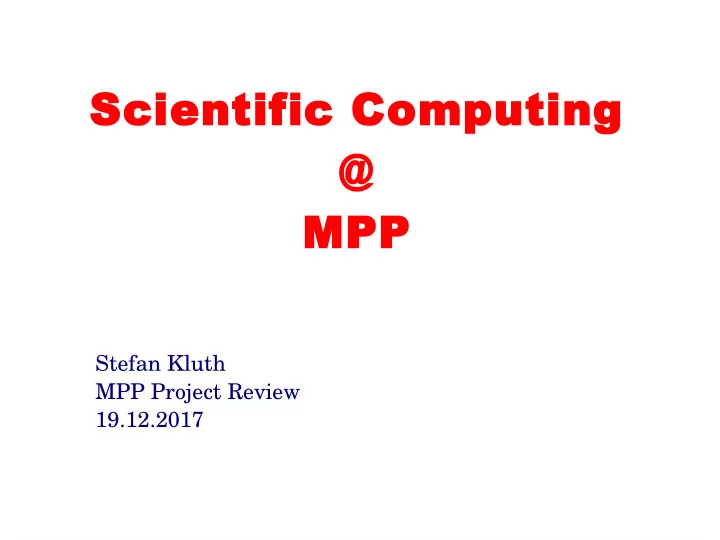

Scientific Computing @ MPP Stefan Kluth MPP Project Review 19.12.2017
Science with computers ● The scientific method (simplified) – Experiment: design a setup and collect data, infer from data underlying principles; test theories – Theory: build up from fundamentals a mathematical framework to describe nature and make predictions; learn from experiment data ● With computers – Numerical simulation: translate abstract / unsolvable models into practical predictions, discover behavior – Find structures in (unstructured) data Scientific computing @ MPP 2
Overview ● Some applications – ATLAS – Theory: see Stephen Jones talk ● Data Preservation ● Software development example – BAT ● Resources – MPP, MPCDF, LRZ, Excellence Cluster (C2PAP) Scientific computing @ MPP 3
ATLAS WLCG Tier-0: CERN Tier-1: GridKa Tier-2: MPPMU Originally hierarchical, moving to network of sites MAGIC, CTA, Belle 2 following this model, our Tier-2 supports this Scientific computing @ MPP 4
ATLAS MPP Tier-2 & Co 50% nominal Tier-2 1/60 of total ATLAS Tier-2 Incl. “above pledge” contributions DRACO is HPC at MPCDF “opportunistic” Scientific computing @ MPP 5
DPHEP Andrii Verbytskyi ● MPP has several experiments with valuable data and ongoing analysis activity ● H1 and ZEUS @ HERA ● OPAL @ LEP and JADE @ PETRA ● See Andrii Verbytskyi talk – and previous project reviews since 2000 Scientific computing @ MPP 6
DPHEP ● Save bits: copy data to MPCDF – Provide access via open protocols (http, dcap) – Use grid authentication (X509) – About 1 PB (H1, ZEUS, OPAL, JADE), goes to tape library ● Save software: installation in virtual machine – Provide validated environment (SL5, SL6, ...) ● Save documentation: labs, inspire, … – Older experiments: scan paper-based documents Scientific computing @ MPP 7
Scientific computing @ MPP 8
Scientific computing @ MPP 9
Bayesian Analysis Toolkit (BAT) Oliver Schulz ● Markov Chain Monte Carlo (MCMC) sampling – Metropolis-Hastings algorithm ● Sample likelihood (model + data) – As function of model parameters – Contains prior pdf for model parameters – Result is posterior pdf for model parameters given a data set ● Can be computationally costly – Many model parameters – Large data sets – Complex model Scientific computing @ MPP 10
BAT Bayes Theorem: P( ρ |X) ~ P(X| ρ )·P( ρ ) X: data set, ρ : model parameters, P(X| ρ ) model likelihood, P( ρ ): prior likelihood, P( ρ |X) posterior likelihood of ρ given Data set X and model in P(X| ρ ) Metropolis-Hastings Algorithm: P a (x i+1 |x i ) = min( 1, P(x i+1 )P p (x i+1 |x i ) / P(x i )P p (x i |x i+1 ) ) Proposal density P p (x i+1 |x i ) Scientific computing @ MPP 11
BAT Two results q 1 = 2.4 ± 0.12; q 2 = 2.0 ± 0.10, norm. N = 1.0 ± 0.15 r i = Nq i and ρ = ηα for parameters ρ ↔ r i , η ↔ N, α ↔ q i Average of r i is estimator for ρ Model likelihood: P({q i },N| ρ ) = ∫∫ d( ρ - ηα )G({q i }| α )G(N| η ) d α d η = 2.164 ± 0.334 〈 ρ 〉 Scientific computing @ MPP 12
BAT ● BAT up to 1.0 bat.mpp.mpg.de github.com/bat – Stable product, large user base, many publications – C++ incl. Root – BAT 1 not easy to integrate in e.g. python, R, etc. – Code not optimal for parallelism – Not easy for other sampling algorithms ● BAT 2 project – Rewrite in Julia language (first usable release expected in 2018) Scientific computing @ MPP 13
Theory Thomas Hahn Scientific computing @ MPP 14
Theory Scientific computing @ MPP 15
Resources: general ● MPCDF – Hydra: 338 nodes with dual Nvida Tesla K20X, 2500 new nodes 40 cores arriving – Draco: midsize HPC, 880 nodes 32 cores, 106 nodes with GTX980 GPUs ● LRZ – SuperMUC: >12.000 nodes, 241.000 cores, fast interconnect – To be replaced soon SuperMUC-ng ● Excellence Cluster Universe – C2PAP: 128 nodes, >2000 cores, fast interconnect, SuperMUC integration Scientific computing @ MPP 16
Ressources: MPP@MPCDF ● Computing – 144 nodes, 3.250 cores – SLC6, SLURM batch, singularity – WLCG – User interface nodes mppui[1-4] – mppui4 (fat node) has 1 TB RAM ● Storage – 4.5 PB storage on RAID arrays – IBM gpfs shared filesystem (/ptmp/mpp/...) – dCache data storage (xrootd, http, … ) – Connection to tape library via gpfs possible Scientific computing @ MPP 17
Resources: MPP ● Computing – > 200 desktop PCs via condor batch system ● Ubuntu 16.04 or Suse tumbleweed – 2 fat nodes with 512 GB RAM (theory) ● Memory intensive programs e.g. reduze (Feyman diagram to master integral reduction) jobs etc – Fat nodes partially with Nvidia GPUs (Gerda group) ● Storage – CEPH storage (/remote/ceph/...) – Local scratch disks (/mnt/scratch/...) Scientific computing @ MPP 18
Virtualisation / Linux containers ● Linux PCs offer VirtualBox – Any user able to run VMs, Windows or Linux – Behind NAT, IP address on request – Host file system access possible – Fixed RAM allocation, heavy images ● Singularity (2.4.x, available soon) – Run different Linux images in user mode ● e.g. SLC6 on ubuntu 16.04, Suse tumbleweed on SLC6 on MPP cluster at MPCDF … ● Must be root to build images use VMs → – Share host filesystem e.g. /remote/ceph or /cvmfs Scientific computing @ MPP 19
Summary ● Scientific computing essential for our success ● Many activities at MPP – From software development to data preservation ● Resources: MPP, MPCDF, LRZ, C2PAP ● All centers provide application support – Porting to parallel platforms, performance tuning, … ● Transition to HPC in many of our research areas Scientific computing @ MPP 20
Recommend
More recommend